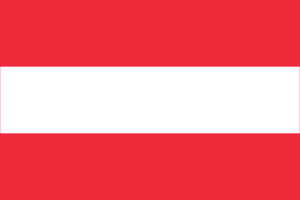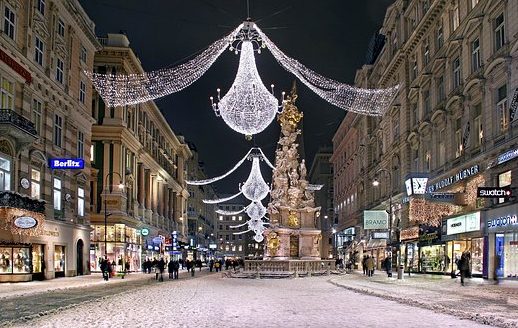21 December 2017
Herr Strache and the Freedom Party
The far-right in power in Austria.
By Neil Tidmarsh
 I was in Vienna three weeks ago. It was the first time I’d visited the city, and I was delighted to find it as beautiful as I’d hoped. Grand imperial palaces, splendid baroque churches, intimate cobbled streets, wide tram-traversed thoroughfares, a white cityscape trimmed with gold and red. It even snowed, just to add the finishing touches to a fairy-tale metropolis which seemed to have a Christmas market in every platz. We visited St Stephen’s Cathedral and Mozart’s house in the old town. A friend insisted that we should see something of new Vienna and took us beyond the Danube to the second district, the ‘donau city’ development, with its new University of Economics And Business (library and learning centre by Zaha Hadid) and the 220m tall, 58 storey, Dominique Perrault designed DC Tower 1, the tallest skyscraper in Austria.
I was in Vienna three weeks ago. It was the first time I’d visited the city, and I was delighted to find it as beautiful as I’d hoped. Grand imperial palaces, splendid baroque churches, intimate cobbled streets, wide tram-traversed thoroughfares, a white cityscape trimmed with gold and red. It even snowed, just to add the finishing touches to a fairy-tale metropolis which seemed to have a Christmas market in every platz. We visited St Stephen’s Cathedral and Mozart’s house in the old town. A friend insisted that we should see something of new Vienna and took us beyond the Danube to the second district, the ‘donau city’ development, with its new University of Economics And Business (library and learning centre by Zaha Hadid) and the 220m tall, 58 storey, Dominique Perrault designed DC Tower 1, the tallest skyscraper in Austria.
But I also visited Bergstrasse 19, just outside the Ringstrasse, where Sigmund Freud lived and worked for over five decades from 1886. His consulting room and the family apartment are now a museum. It was here and during those years that he formulated his theories and undertook his ground-breaking work. In 1938, however, he was driven out by the Nazis and had to flee to England. He took his iconic couch with him – it can now be seen in Hampstead, London, where his consulting room and home are also a museum. The Vienna museum considered exhibiting a copy of the famous couch but rejected the idea, deciding that its absence would be a powerful symbol of everything and everyone the Nazis displaced. Indeed the whole museum is a powerful symbol of everything and everyone the Nazis displaced and erased – it’s almost completely empty of furniture, with the exception of one battered travelling trunk which has been returned from Hampstead for exhibit and proves to be an extremely poignant artefact.
The letters, photos and articles displayed on the walls are painful reminders of Nazi atrocity. Freud’s sisters didn’t manage to escape in time and they all perished in death camps. There are photos of Freud with the Austrian writer Stephan Zweig (he whose spirit inhabits the movie “Grand Budapest Hotel”) who did manage to escape from Austria, but committed suicide with his wife in Brazil in 1940, traumatised by what was happening in Europe. There’s a letter from Freud to the Viennese doctor and writer Arthur Schnitzler (a particular favourite of mine – why isn’t his work more available and better known in English? – translations of his dramatic, perceptive and often funny novellas are beginning to trickle out one by one from various small publishing houses here, but I’ve had to cross an English language edition of his plays off my Christmas present list because none is in print). Schnitzler died in 1931, seven years before the Anschluss, but his work was condemned and banned by the Nazis after his death.
This week, chants of “Nazis out” echoed around Vienna, suggesting that some of this darkness still lurks in this beautiful city’s subconscious, in danger of rising to the surface again. Demonstrators were marching in protest against the new coalition government inaugurated on Monday, two months after inconclusive elections. The new chancellor, Sebastian Kurtz, has formed an alliance between his conservative People’s Party and the far-right Freedom Party. The Freedom Party (which came third in the elections with 26% of the vote) was formed in 1956 by former Nazi officers, and from 1986 to 2000 it was led by Jörg Haider, a candid admirer of Hitler. Its current leader, Heinz-Christian Strache, has a history of neo-Nazi activity. As a young man he took part in torch-lit demonstrations with a now-banned fascist group, and was detained by the police. His Facebook page has featured anti-Semitic cartoons.
Herr Strache is now Vice-Chancellor of Austria and his party has eight ministries, including foreign, interior and defence, which gives him control of the army, police and intelligence services. Ultra-nationalist policies have already been announced, including an offer of Austrian passports to German-speaking ethnic Austrian citizens of Italy resident in Alto Adige, the province known in Austria as South Tyrol and ceded to Italy after defeat in World War I, and where a secessionist movement is growing. Italy isn’t impressed by this initiative; its own far-right parties are blustering aggressively at the insult, but the centre left Democratic Party issued a more serious warning, saying that dividing people “into first and second division citizens, based on a presumed ‘blood line’, is a mistake and recalls dangerous ghosts from the past”.
Earlier this year, in France, Marine le Pen went head to head with Emmanuel Macron for the Presidency; her far-right Front National party had emerged neck and neck with the two mainstream parties in previous elections. In Germany, the far-right AfD (Alternative For Germany) won 13% of the votes (that’s 6 million supporters) in September’s election and now has 94 seats in the Bundestag, which makes it the third biggest party; Angela Merkel has been trying to put a coalition government together without the AfD for the last three months, but the task is proving near-impossible. And now, in Austria, a far-right party is in power. This isn’t supposed to be happening in today’s Europe.
A brain haemorrhage killed Arthur Schnitzler before the Nazis could get their hands on him, but his son Heinrich left Austria in 1938 and fled to the USA. Heinrich returned to Austria in 1959 with his son, Michael, who was born in Berkeley, California, in 1944, and who is now a famous Viennese musician and conservationist. Let’s hope that no one ever has cause to regret any such return.


